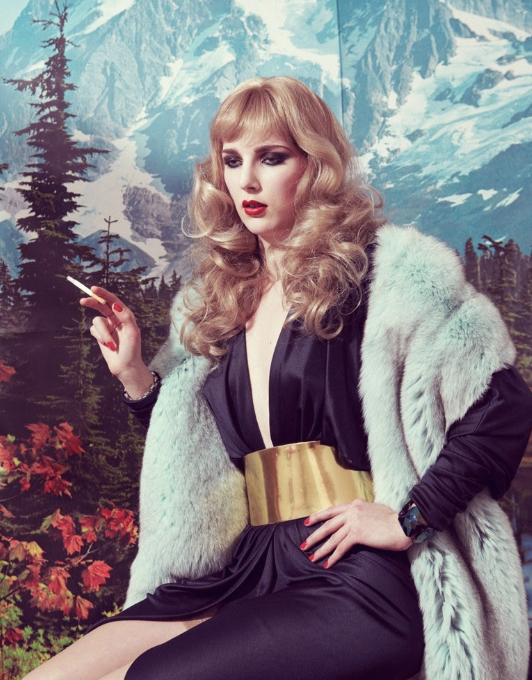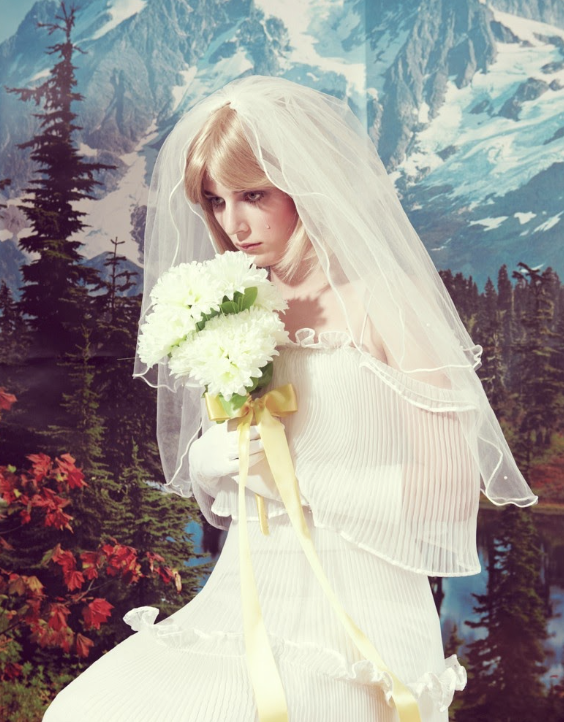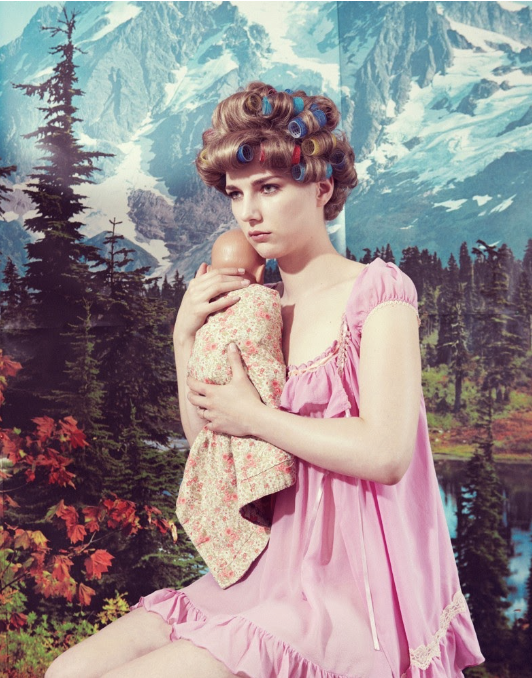“The Ideal Woman” Exhibition from Kourtney Roy, Reviewed By Lola Draper
A Cheerleader with her hair in pigtails grasps her pom poms, gazing bleakly past the lens of the camera. A uniformed flight attendant holding her serving tray, stiff as a board. A beautiful bride appears ready to walk down the aisle in her bouquet and veil, and what was supposed to be the most exciting day of her life is contrasted by her sterile gaze. A dedicated secretary, a prostitute in tights, and a crowned pageant winner with her flowers in hand. All the portraits are staged in front of a mountainous landscape. The contrasting backdrop of “the great outdoors” makes the portrait exhibition that much more intriguing given it might be a landscape traditionally associated with a male or masculine persona. A maid with her duster, a mother with her child, a wife that cooks, and a woman dressed in fur and holding her cigarette; are all encapsulated in these gimmicky portraits. From one photograph to the next, a despairing, but honest theme emerges. The images all portray cliché stereotypes of how women should act and dress in society.
Kourtney Roy’s photo exhibition “The Ideal Woman” captures the continuing proliferation of female stereotypes. A commentary that has a long lineage of expression, one mainly being Cindy Sherman. These artists speak and act on the disgusting long established stereotypes of women and the longevity of these stereotypes in our society. Artists throughout history have illuminated and shed light on society's flaws, and Roy is no exception. Through this exhibit, Roy brings awareness about the outdated stereotypes of women in today's society, both in the workplace and in the public eye, by doing what she does best, photography. The characters Roy portrays are trapped in the past and confined by shallow cliches. These women, dressed in familiar uniforms are recognizable, but instead of the images invoking feelings of comfort, they feel empty and cold. They are visibly unhappy and distant. This can be perceived as a statement to the unfairness of stereotyping the “Ideal Woman.”
This exhibition was inspired by influences from film, pornography, and advertising industries of the 50’s and 60’s. A poignant reminder of the fact that the more things change the more they stay the same. Issues that pushed women down decades ago are still plaguing us today. Roy commits to living the parallel lives in each photograph in the exhibition, displaying herself as “The Ideal Woman.” This is also a parallel to the construction of identity that artist Cindy Sherman did decades of work experimenting with. From the uniform of a flight attendant or a cheerleader, she is transformed by her hair, make up, and clothing into the myriad of typical and unfair expectations that are wrongly appointed to women. Each identity consists of many parts. Roy employs costume changes from a maid to a stewardess to differentiate the women in her photos. She also made use of props by holding pom poms or a baby or a wedding bouquet to give the character life and depth and to further emphasize how deeply ingrained these stereotypes are in society; almost to the point of becoming cultural norms. Roy’s use of make-up ranges from that of a rich woman with a dramatic eye and red lip to the tear falling down the bride's cheek. Much like Sherman, with these transformative characters it is clear that the difference from one photo to the next is dramatic, making it hard to believe that it is all one artist. She also keeps the same background, a landscape that reminds one of old portrait studios. This “kitsch” look is a main part of the aesthetic. She believes “...that kitsch is part of a larger world, which is made up of the everyday … Kitsch is woven into the fabric of these magical places. It is in these mundane sets that the marvelous resides.” She invites us to explore the worlds in the photos. From an adolescent cheerleader to a mother, from a pageant queen to a prostitute, the range in which Roy transforms covers a wide spectrum. That is a challenge of itself, but she also has to emotionally transition in each character. The mindset of the women had to be accessed in order for the exhibition to relay the message. That emotional toll must have taken a great deal of effort, but she accomplishes telling a different story in each photo. I believe that this heightens the variety and range of impact.
Despite the identical backgrounds, the women exist separately, yet also can be observed in parallel worlds created by Roy. These heterotopias, or worlds inside of worlds, are solely built by the ambiance that the characters give off. They seem dim and somber; their eyes lifeless and wandering. Their emotions, or visible lack thereof, exert a grim hopelessness, encapsulating their sad existence. We can envision the life they are living; the life of a secretary, a maid, and a woman in fur. The depth and story told by the photographs is remarkable and difficult to obtain, and definitely resonates with the viewer. Roy talks of her passion about the heterotopias in art. “I love how someone’s work can show me a universe that I never even knew existed,” she explains, and that is the exact way I felt when viewing her exhibition. This is an exhibition that makes a meaningful statement. Many people do not realize the importance of happiness within your own life, or take it for granted. We, as the audience, are given the ability to connect and engage with the women strictly by their look and their obvious desire for change. These women, unwillingly suppressed by the reigning patriarchy, give a subtle reference to the act of unconsciously representing women as sexual objects solely for the pleasure of the male view. Roy accomplishes the challenge to take on the hardships of the male gaze in a way that is comprehensive. Just like Cindy Sherman, she is the object, as well as the objectifier. Being their own models, they have that much more control on the meaning behind their works. The message behind this exhibition is extremely loud, and to me, is demanding to be heard. It is the twenty-first century, the demand for change is constant, but real change seems to be slow moving. Although it is improving, “slowly but surely” is not the ideal pace for improvement. I know it can not happen in a day, equal respect rather than discrimination needs to be learned and practiced.
Sadly, despite both Sherman and Roy’s work, as well as I'm sure thousands of others, this compartmentalized image of the stereotypical “Ideal Woman,” continues to be tremendously present in our society today. Despite having made great strides to shatter these cliches since women’s suffrage, there is still much to do. The exhibition illuminates a sad but stark truth. The subjects in the photographs are all too familiar. Tragically, women all too often recognize and relate to the roles staged in the photographs; despite having shattered so many of those cliches and biases. The irony that these cliches have more than a shred of truth so many years later serves as a wake up call. Kourtney Roy’s work is rooted in feminism which continues to be critically important. Roy’s work connects with her audience on the most human terms. I am inspired by these artists' work and I think that may just be the point. I now have the ability to carry the conversation forward and will help speak up more boldly about gender discrimination and shameful stereotypes of women.



